|
Monday, April 19, 2010
Progress Notes
Last week we were honored when we received an original hand crafted reproduction of the home and barn of the Oligschlaeger family of St. Elizabeth which Robert Urban Oligschlaeger (photo 01) recently completed after more than seventeen years of work.
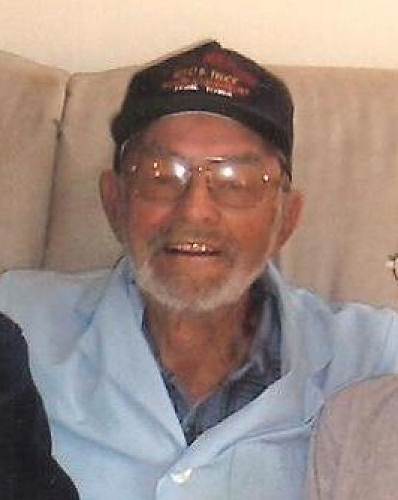
01 Robert Urban Oligschlaeger According to the family, he always enjoyed woodworking and after retiring in 1985, created many beautiful objects from various types of wood for his children and grandchildren. During this time he created an exact replica of the old homestead barn and house where he grew up. Since both had been torn down, he did this all from memory.
Many residents of the area will remember Bob, sometimes known as “Doc,” when he lived in Tuscumbia during the time he owned and operated the Anchor Mill Company which he had purchased from Homer Clay Wright in the mid 1970’s. Others will remember him from his high school years since at that time in the late 1930’s both St. Elizabeth as well as Iberia sent their children to Tuscumbia for high school since neither of those communities yet had a high school. Bob and his wife, Marjorie, now are living in Iowa (photo 02).
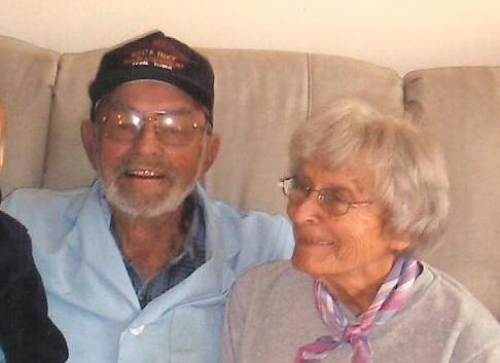
02 Bob and Marjorie Oligschlaeger The model home and barn were delivered to us by three of Bobís daughters, Marty Oligschlaeger, Judy Oligschlaeger Meyer and Mary Oligschlaeger Wright (photo 03).
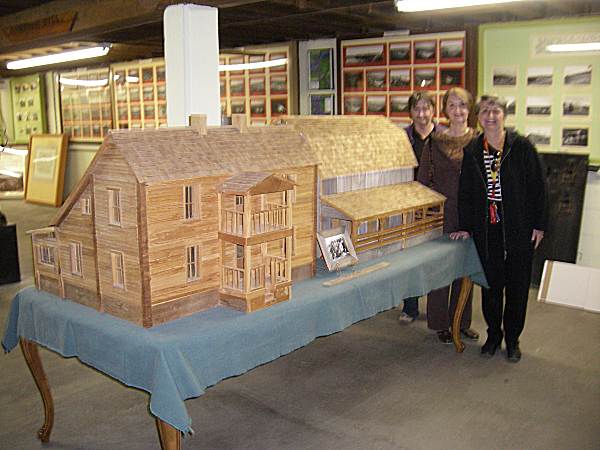
03 Marty, Judy and Mary with House and Barn The original Oligschlaeger home where Bob was raised is still standing in St. Elizabeth south of Highway 52 on the east side of town as one is heading toward Meta (photo 04).
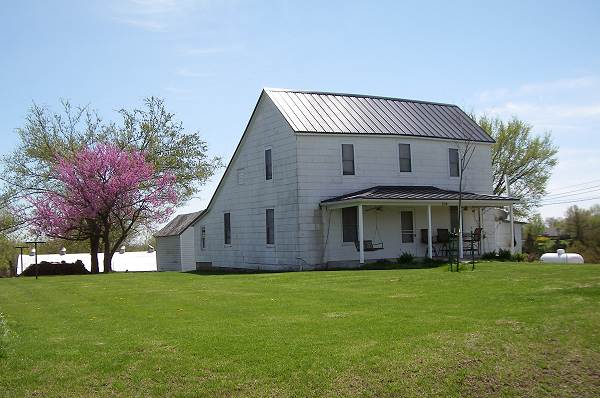
04 Oligschlaeger Home The siding now in place has been added in recent years as originally the home had wooden siding as depicted in the model. The barn originally was located to the west of the home and oriented at ninety degrees to the house. Here are some older photos of the home (photos 05, 06 and 07):
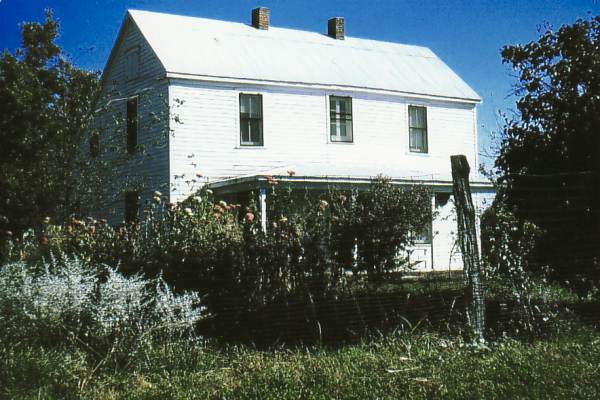
05 Oligschlaeger Home
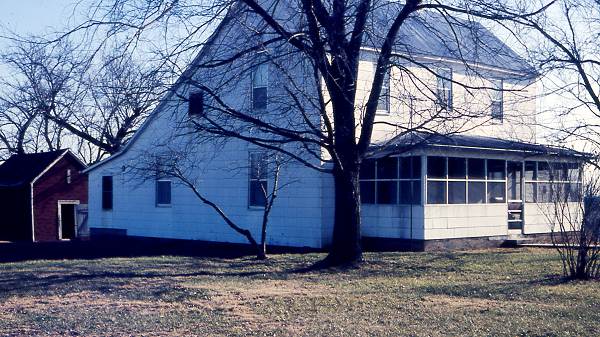
06 Oligschlaeger Home
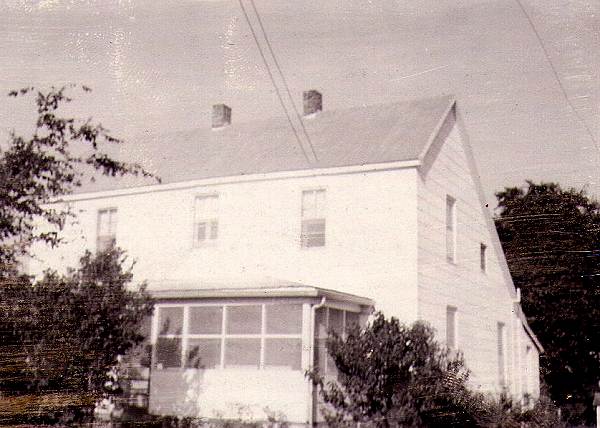
07 Oligschlaeger Home No photo is available of the home before siding was placed on it.
The Oligschlaeger farm had a pond built on it by the WPA during the depression. In this next photo you can see it in the back ground (photo 08).
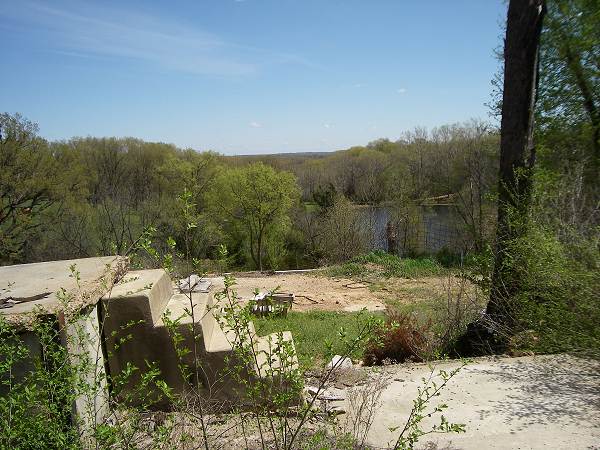
08 Old Mill with Lake The crumbling foundation in the foreground is what remains of a mill which originally was owned by Bob.
Bob was born in 1923 at St. Elizabeth, MO, the son of Bernard (Ben) and Alma Schell Oligschlaeger (photo 08a).
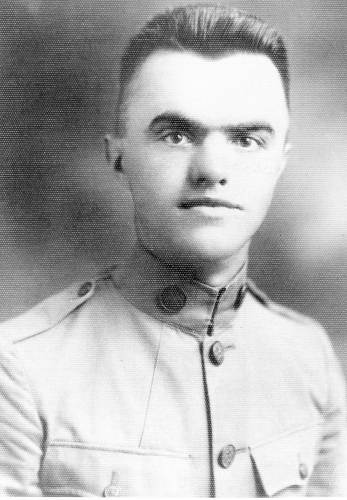
08a Bernard Fredrich Oligschlaeger (Father of Robert U.) His father died in 1938 and he helped his mother run the farm until his enlistment in the Marine Corps during WWII.
Bob was a very successful Miller County business man having had several agricultural enterprises, mostly having to do with commercial turkey operations and owning and operating feed stores in St. Elizabeth as well as Tuscumbia. His daughter, Judy, has written for us a short outline of Bob’s life and career:
Robert Urban (Bob) Oligschlaeger
Biographical Outline
Born March 3, 1923 at St. Elizabeth Missouri; son of Bernard and Alma Schell Oligschlaeger
Attended St. Elizabeth Grade School (was allowed to skip a grade)
Attended Tuscumbia High School (1936-1940) graduating in 1940 (played varsity basketball)
Enlisted in U.S. Marine Corps (1942) serving in the Pacific Theatre WWII 1944-45 (photo 08a)
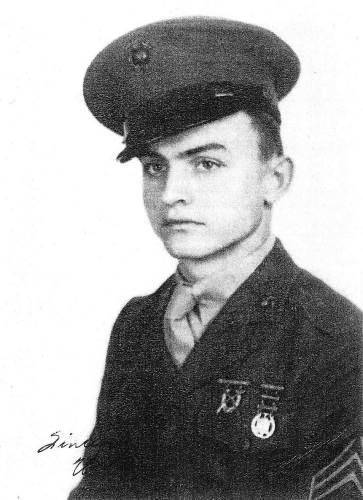
08a Robert Urban Oligschlaeger - 1943 Married Freda Crane (also a graduate of Tuscumbia High School in 1941) (photo 09)
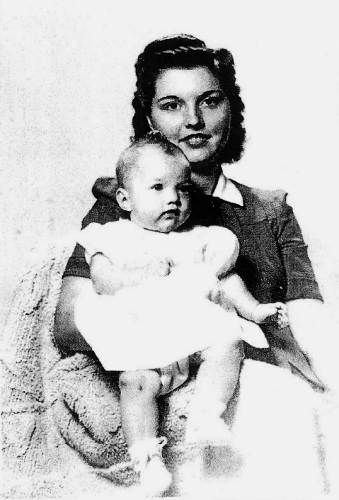
09 Freda and Judy - 1943 Worked and established his own business, Gordon Sound Service in Jefferson City, Missouri 1946-1961)
Moved with his family back to his home town of St. Elizabeth in 1957.
Established St. Elizabeth Farm Supply in 1961; expanding the business in 1966 with the addition of Lawson-Robinett in Tuscumbia
Purchased and lived in C.B. Wright home in Tuscumbia 1975 (photo 10).
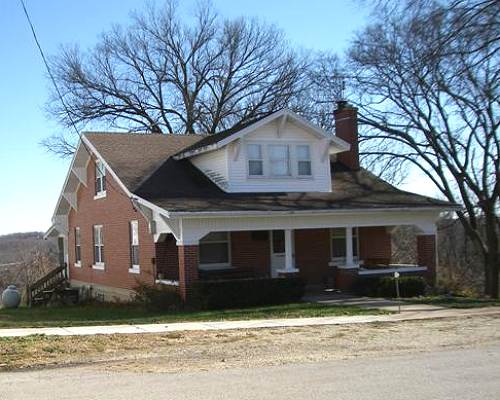
10 C.B. Wright Home Became a widower in 1980 with the sudden passing of his wife Freda
Married Marjorie Schuek of Aplington, Iowa in 1983; they resided in Tuscumbia 1983-1994
Moved to Aplington, Iowa in 1994
My dad has always enjoyed making things of wood with his hands and after retiring in 1985, created beautiful objects out of many kinds of wood. Most of these grace his children’s and grandchildren’s homes today. The homestead house and barn are unique, not only in the fact that they are built in accordance to his recollection of them, but also moving and memorable to all his large extended family.
Judy Meyer
Thanks Judy.
The Oligschlaeger family has lived in Miller County in the St. Elizabeth area for several generations coming here around or before 1887 from Westphalia, Missouri. They were part of the German migration from the East which occurred especially around 1860. The story is well covered by Dale Doerhoff in his book, "St. Elizabeth: The First Century 1880-1980.” The following is quoted from that book:
“By 1837 there were 30,000 German immigrants in Missouri. The largest influx came after 1848. In that year revolution spread across Europe. By 1860, there were 88,000 German immigrants in Missouri. 50,000 were in St. Louis. Others came up the Missouri River and settled in its tributaries, the Osage, Maries and Gasconade Rivers.
They began moving into eastern Miller County about 1870. Old St. Elizabeth, located on the Osage River upstream from the mouth of the Big Tavern Creek, was established in 1869. Old St. Elizabeth was abandoned in favor of the present site of St. Elizabeth which was established in August of 1880. Mary's Home formed around 1883. The building of St. Anthony began in 1906.”
You can read more about St. Elizabeth on our website.
The German population location in Miller County was to some extent determined by whether it was Protestant or Catholic. For example, names such as Nixdorf, Kallenbach and Bear (probably anglicized from Bahr) were of families who were Protestant and lived in Equality Township. The German Catholic population settled mainly in Mary’s Home, St. Elizabeth, and St. Anthony, villages which were located in Jim Henry and Osage Townships. The religious affiliation as well as the language may have caused some isolation for the German Catholic communities early on; however, as the years passed that never became a significant problem.
One thing which may have really increased communication and relationships between the German Catholic community and the rest of the county occurred in the late 1930’s when parents began to think about sending their children to high school after they had finished the lower grades. At the time, St. Elizabeth did not have a high school, nor did Iberia. However, Tuscumbia did have one, so many of the parents of these communities began arranging for their children to travel to Tuscumbia for attendance at the high school there. These students immediately began to mix and socialize and were readily accepted by the Tuscumbia students and community. More than a few marriages of students from the Iberia and St. Elizabeth communities with Tuscumbia students occurred as a result of this opportunity. This certainly occurred in Bob Oligschlaeger’s life as he married Freda Crane (see photo 09), who at the time was living in Tuscumbia and attending Tuscumbia High School.
Those of you who read the Progress Notes of April 12, 2010 may remember that in the photo of the Tuscumbia basketball team which won the Eldon Tournament, one of the players was listed as Urban Oligschlaeger (photo 11).
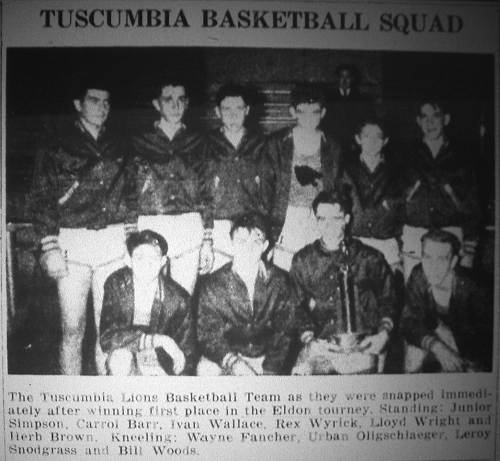
11 Tuscumbia Basketball Team - 1940
Click image for larger viewThis player was Bob Oligschlaeger, the subject of this week’s Progress Notes. Urban was Bob’s middle name. Bob’s oral account of his experience as a high school student in Tuscumbia was recorded and transcribed by his daughter, Mary Wright:
My High School Years
Tuscumbia High School 1936-1940
In the fall of 1936, I began attending high school at Tuscumbia, Missouri. I was 13 years old and that was the beginning of four of the most enjoyable years of my life. I was really happy during that time although I have had many happy years later. These years are memorable because I formed friendships that became lifelong and still exist; and, of course, I also met your mother Freda during those years.
I had turned 13 in March of that year and I was the second youngest and certainly the smallest of the boys in my class. I mention that only because during our school carnival of that year, 1936, I was chosen to be the bridegroom in the parade that preceded the carnival. It was a Tom Thumb Wedding. The bride who was chosen was the tallest girl in the senior class and I was the smallest boy in the freshman class. We were quite a pair. I never will ever forget her. Her name was Lois Mayfield and she lived about halfway between Tuscumbia and Iberia. She was a beautiful girl who later married John Adcock (He owned Adcock’s Café in Jefferson City, Mo.). She lived in Kansas City in later life and is now no longer living. The honor of being chosen was purely because of my size. The size difference was intended to be humorous and we were quite a sight I’m sure. We looked like Mutt and Jeff. It was fun and, oh, boy, I had to get a new suit in order to be in the parade. It was sort of a cheap little suit but it was new.
At that time our class in Tuscumbia was rather large because we had all the people from Iberia. There was no public high school in Iberia so those kids rode to school on a bus just as did all of us from St. Elizabeth. We had a class of 40 to 45 people to start the freshman year. Of course, those numbers changed after our first year because a school was started in Iberia for those students. Some of the students who were in the upper grades from Iberia continued to attend Tuscumbia until they graduated because the new Iberia school was adding just one year at a time starting with the freshman class and sophomore class.
The number in our sophomore class was down to approximately 25 students. We had additions and deletions over the remaining high school years so that we graduated with 23 in our senior class. We were probably the closest knit class that has ever graduated from there. We have maintained that relationship down through the years. Of course, a lot of those people are no longer living, but I have many fond memories of all of them even now. Some of my classmates were Leroy Snodgrass, Wayne Fancher, Truman Fancher, Rex Wyrick, and Bill Woods.
Of course, one of the highlights of my high school years was basketball. It was a popular sport in Tuscumbia at that time and I started playing during my freshman year. There were no junior high sports teams during my years in school so we did not play any competitive games in my first year. In my sophomore year, I started playing on the B team and then we played in competition. Eventually that year I graduated to the A team. It seems like it was sometime after the first of the year. I know that I played long enough in the 10th grade to letter because I lettered all three years on the first team…that would have been my 10th, 11th, and 12th grades. I had a letter sweater with a letter for basketball.
Basketball was an important part of my life then. In my junior and senior years, I was one of the starting five, never missed a game, and fouled out only once that I can remember in my entire career. I was a guard. Although I was one of the smallest (because I think I was only about 5 feet 6 inches when I graduated), I had tremendous timing and leaping ability for rebounding. I was not a high scorer and probably did not average over 2 or 3 points a game but I was labeled “the man back.” Of course, scoring then was a lot lower than it is now days. It was an entirely different type of game…much slower paced and no three point shooting. It was primarily a game of defense. The year that we won the Eldon tournament, the final score was 16-14. It was a hard fought game and was the first time that Tuscumbia ever beat Eldon. There has been only one time since to my knowledge that Tuscumbia won the Eldon tournament. We were considered school heroes at the time in Tuscumbia but, of course, not outside that community.
In my senior year our record was 34 and 6. We lost all 6 of those games in tournament action. We played in seven tournaments and won two. We won the league tournament. During that year, some of the teams in the league were Olean, Brumley, Iberia, Eugene, and Tuscumbia. Of course, some of these towns no longer have high schools.
At Olean I recall that we played on an outdoor court at night. They had makeshift lighting arrangements. They were certainly nothing like the flood lights that we have now. I remember it was cool because it was in the fall of the year. We even played with a different kind of ball. It had raised seams on it and dribbling was virtually impossible. It was a fun and interesting experience.
We played all over the state of Missouri. We traveled sometimes by bus but also sometimes in private automobiles. Our coach had a car and some of the team supporters drove us. We made one trip to northeastern Missouri and one trip to play a team in Quincy, Illinois. We went to Carthage, Fulton, Cahokia, Waynesville, Eldon, California, and Versailles. Sometimes we had tournaments and sometimes single games. We traveled much farther than they do now because there weren’t as many teams in close geographical proximity like there are today.
Sometimes we played in 16 team tournaments and we would travel to play 4 games in three days. We would sometimes stay over at other player’s private homes such as at Fulton, Versailles, and Carthage. I don’t think that there were any motels and we certainly couldn’t afford hotels. We traveled a long distance on a small amount of money. I recall on many occasions that I only had 25 cents in my pocket. I know that I only had a quarter for the trip to Illinois but you could buy a lot for 25 cents in those days. Of course, all of our expenses like meals, transportation and lodging were provided. It was a great experience for me and one in which I gained a lot of knowledge about life outside of St. Elizabeth. One of the games that sticks out most in my memory is when we played in the semifinals of the 1940 Fulton tournament when we met the University City High School team from St. Louis. They were seeded number one and were expected to win the tournament. We beat them 25-20. It was one of the best games that I played in my entire time of ball playing. I also played a great game against Carthage as I remember it.
I made the All Star Team in two of the tournaments my senior year. That was at Fulton and Eldon where I won a little gold basketball. It was a little trinket type of award but it was very prized and valued in those days so I was very proud of it. I still have one of them. Your mother wore those awards while we were dating in high school. It was like giving a girl a class ring in those days.
Note: here is a photo of one of those the gold basketballs awarded to the team; this one belonged to Rex Wyrick (photo 12):
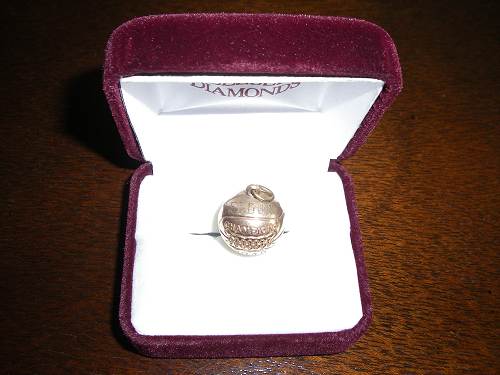
12 Eldon Tournament Award - 1940 In 1938, my sophomore year, the starting five were Leroy Snodgrass and I as guards, Harry Hall and John McNatt as forwards and Dorril Wright as center. Just like football heroes in high school today, we were much applauded. Maybe it even went to my head a little bit.
Benny Campbell was my coach my sophomore year. During the fall of 1938 and thereafter my coach was Paul Thayer. He came from Cahokia and that was why we made the trip back to that area to play ball. It is north of Hannibal on old Highway 61.
The school provided us with a uniform but we had to buy our own shoes. That was quite an expense for me although they probably only cost a couple of dollars. We also had to buy our own books in high school. They probably cost 8 to 10 dollars per year.
The starting five on the 1940 team was probably the best team of players that ever played for Tuscumbia. They may not have been the highest scoring team but it was the most solid team…Wayne Fancher and I were the guards, Rex Wyrick was the center, and Leroy Snodgrass and Bill Woods were the forwards. We enjoyed playing as a team.
During the 1940 season, the team won second place in the Fulton Tournament and I made the all star team along with Bill Woods. We played four games and won three of them. We lost the championship game to Bland. In getting to the finals, we beat Richmond, Bowling Green, and University City High School. That, of course, was a large city high school. In those days, everyone competed in the same class from all over the state no matter what the size of the school. We were competing against the Jefferson City Jays and teams from Carthage. Some teams traveled over hundreds of miles to compete.
We played only in single elimination tournaments with consolation brackets. These games were all played in three days. As long as the team kept winning, they kept playing. We did not travel back and forth but stayed instead in the homes of some of the players from the tournament hosting team. In Fulton, we stayed on Court Street. If you have ever read King’s Row, you know that street is mentioned in the book. It was a very nice place. We even stayed in Versailles and Waynesville instead of traveling back and forth.
We rode a bus back and forth from St. Elizabeth to Tuscumbia on a daily basis for high school. It was Ray and Leonard Doerhoff, Shorty Rehagen, Frank Holtmeyer, my brother Leroy and myself. Some of them were a year ahead of me. They originally rode to school with Uncle Otto Schell and returned with him in the evening. He was the county treasurer at the time and he made the trip to work at the courthouse where his office was located.
Note: Here is a photo of Shorty Rehagen I happened to have in my files (photo 13):
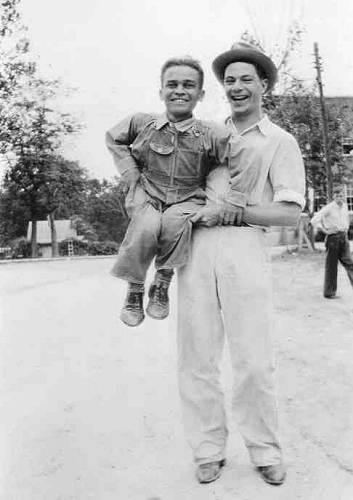
13 Harold Pryor and Herman Shorty Rehagan However, in the summer of 1936 before I started to high school, Johnny Otto bought a bus for us to ride. It cost $2 a month, 10 cents a day to ride that bus the 30 mile round trip to Tuscumbia for school. That bill had to be paid by us every month of my first year. After that the state paid for our transportation. The district had to pay our tuition at Tuscumbia. Of course, we took our own meals to school because there were no school lunches. There was a Messersmith Hilltop Café where some of the students ate lunch but I could not afford that expense.
During my freshman, sophomore and well into my junior year, I was a good student and was at the head of my class and could very possibly have been valedictorian of my class. However, my good academic record did not extend into my final semester as a junior and then as a senior. I let my grades fall because I was too interested in other things. Honestly, I became more interested in girls and basketball than I was in maintaining my academic record. That’s the truth. I am not going to pull any punches on that topic!
I had no love interest in high school until my junior year when I became acquainted with Freda Crane. We began going together in the fall of 1938…my junior and her sophomore years in high school. We began going steady and were serious about each other during the better part of our junior and then senior year. Of course, as you know, that was the beginning of our life together which extended until her death in the fall of 1980.
When I say we began going together, of course, I did not have a car (as a matter of fact, I did not have a car until I was out of the service and was 24 years old. We had already been married three years by that time). We did not live in the same community so we saw each other at school and school events. In addition to the ball team traveling to the sporting events, other students would go along to support the team. Freda did that and, of course, she had to pay a dime to do that. Johnny Otto drove that bus for us.
I don’t think that Johnny Otto ever made any money driving the bus for us to school or to sports events, but he seemed to enjoy doing the job and I think he went along to the basketball games for the fun of it. He eventually married Capitola Rehagen and then died during WWII. He was a wonderful fellow who was good to us kids and interested in everything that we did. He had a brand new bus that he had bought in St. Louis. We were the envy of everybody because we had such a fine bus. Everybody else in the county had “home built” buses and we had a factory produced bus.
Your mother was a year behind me in school even though she was almost a year older than I was. That, of course, was due to my skipping one year and due to her being held back a year in grammar school due to illness. She had both whooping cough and diphtheria as a child during one school year. She also did not start to school as early as I did. I think she was almost seven when she started.
I did finally wind up third in academic ranking in my class but that was not important to me at the time. I feel that I received a pretty good basic education at Tuscumbia High School. It was more basic than it is today and, of course, we did not have the variety of curriculum that there is today. We did finally in my last two years have typing offered and that is where I learned to type and am still able to do that a little bit. That typing education was really useful later in the service when I had a three month course in Morse code and typing at Texas A & M. I could type at approximately 55 to 60 words a minute. Of course, I could no longer type that fast.
The subjects that we studied in high school were algebra starting in freshman year and then in sophomore year most people graduated to advanced algebra. Junior year we studied geometry and then as seniors we studied trigonometry. We had no calculus then like now, but I wished many times that I had studied calculus especially later when I was in service. I really needed it then. Without the aid of calculus it was difficult for me to master some of the subjects that I studied at the Naval Research Center in Washington in radio and radar maintenance schools.
During those days, it took 16 credits to graduate so we had 4 units a year. We had only two years of English. We also studied General Science and American History the first year. Later on we had Missouri and World History. In science there was nothing offered that provided laboratory work like Chemistry. We did not have anything beyond General Science. There was Speech, Business Education, and Shorthand. We also had four years of Agriculture or Home Economics. Not everybody took them for four years. I only studied Agriculture for two years. It was a good course. T.C. Wright was the instructor and he staffed in wherever he was needed. He was also the superintendent and a very fine man (photo 14).
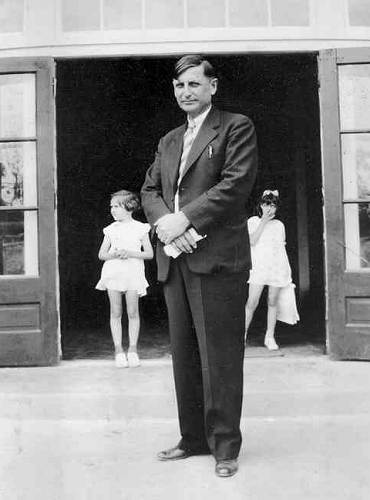
14 Tennyson Clay Wright Eska Fendorf was also an excellent teacher. She was related to Benny Campbell in some way.
Note: Eska Heltzel Fendorf was from Iberia but later married Bob Fendorf of Tuscumbia (photos 15 and 16).
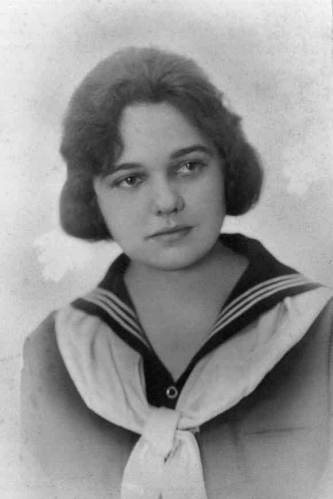
15 Eska Heltzell
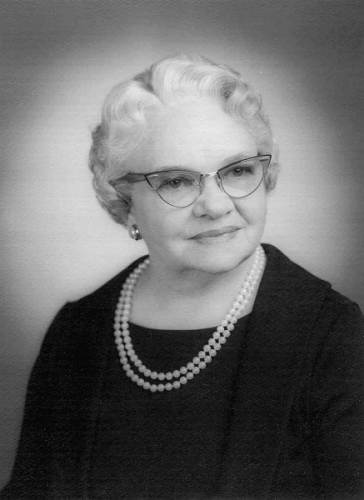
16 Eska (Heltzell) Fendorf Benny Campbell was the principal for most of my high school years and then he went to Climax Springs. He was an excellent math teacher. Juanita Messermith Stillwell was the English teacher.
Note: Juanita was the Miller County Centennial Queen in 1937 (photo 17):
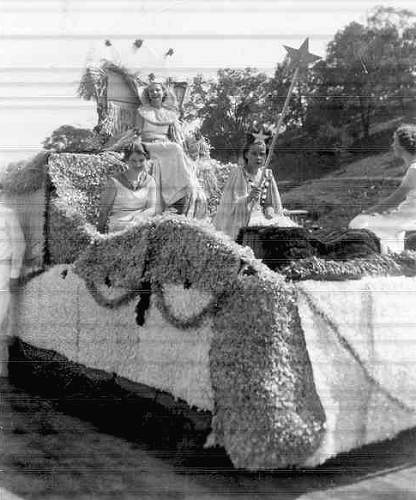
17 Juanita Messersmith Centennial Celebration Bertha Doubikin Harris was the home economics teacher. George Koske taught advanced math and business. He was not as good a teacher because he was not a disciplinarian and could not maintain order.
In English we studied English Literature and Speech was studied by seniors.
One of the highlights of my academic career was in freshman and sophomore years I had to have an FFA project. We had some sheep probably about 15 females and a ram. Those sheep more or less put us through high school. We had two crops a year…the lambs and the wool. We did very well with them. It helped buy our clothing, paid for the bus fare, bought our books and provided any other incidental expenses of going to school.
We had field trips to Jefferson City for Missouri History class. We visited the state capital and penitentiary. We also visited the government office there. I still have my Missouri History textbook. I think it is the only one I still have.
One of the friends Bob had in high school at Tuscumbia was Rex Wyrick (photo 17a), who played with him on the winning Tuscumbia basketball team.
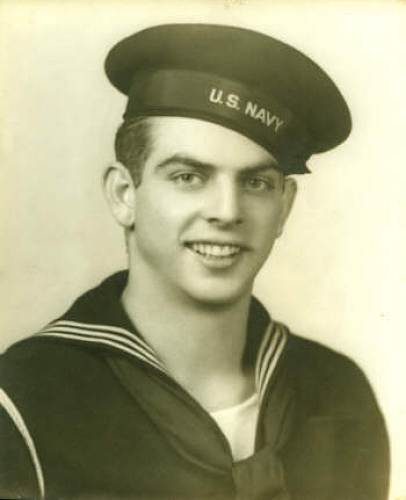
17a Rex Wyrick - 1942 Rex’s daughter, Karen Wyrick, who is a member of our MCHS board, found a letter Rex had written to a friend in 1940 describing just how much affection Rex held for Bob Oligschlaeger (photos 17b - 17e).
Click on each thumbnail to view a larger image.
Rex later in life was our area’s Representative to the Missouri legislature (photo 17f).
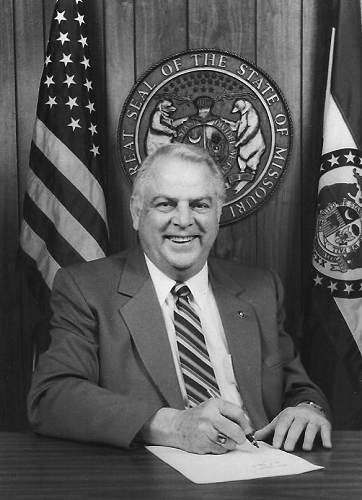
17f Rex Wyrick - State Representative for Miller County
I asked Judy Oligschlaeger Meyer how Bob got the nick name “Doc.” She said that he always wanted to be a doctor; he enjoyed the science courses in school, and even had a couple of medical books he was given by one of the physicians in St. Elizabeth. However, she said that around St. Elizabeth and his own home, he usually was addressed by his given name, not “Doc.”
After reading the entire transcription Mary Oligschlaeger Wright had made from the recording she took of her father’s oral history of his life and family, I thought it was of very significant historical interest regarding the culture and lifestyle of the German immigrants who had settled in St. Elizabeth throughout the 19th century. Although similar in many ways to all of those who lived in rural Miller County during that era, some interesting differences also were present. For that reason, I thought I would devote most of this week’s Progress Notes to Bob Oligschlaeger’s memories of St. Elizabeth during his early years of life:
Chapter 1
Early Oligschlaeger Ancestors Settle in Miller County
Marriage License Records listed in Volume II of Judge Jenkins’ History of Miller County show that a license was issued to Ben Oligschlaeger and Mary Schairznierler (Schanzmeyer) on February 8, 1887. This indicates that the Oligschlaeger family had moved to the St. Elizabeth area prior to 1887. Mary Schanzmeyer was a native of Westphalia, Misssouri and I can only guess as to why the marriage was held in Miller County. The ceremony must have been performed in the old St. Elizabeth church which was located on the Osage River towards Hoecker in Miller County.
I don’t know the exact year my family came to Miller County but I do know the reason they came. My great grandfather whose name was Wilhelm Oligschlaeger (in English that would be William) left the Westphalia area because his wife had died a tragic death there…she committed suicide. She had attended a mission service where she was convinced by a visiting missionary that her daughter had committed an unforgivable offense by going to St. Louis to get a job. In my great grandmother’s mind her daughter was condemned to hell and great grandmother became so despondent that she committed suicide. (I have been to the house near Westphalia where my great grandmother lived at the time of her suicide. It was a rock house that was built like a “dog trot cabin” that had a center area with two separate houses out to the side. The stone in the house was native rock and quarried there along the Maries River Bluffs area.)
Shortly after her suicide, my great grandfather Oligschlaeger moved his entire family to St. Elizabeth. Apparently, it was a young family at the time because most of his children married local people after they moved to St. Elizabeth with the exception of my grandfather, Bernard Oligschlaeger who married a Westphalia girl named Mary Elizabeth Schanzmeyer. They settled on what I always called the Oligschlaeger family farm. It never had a name other than that to my knowledge. The farm was purchased from a man named Harmon Barnhart and that is where my father and my aunts and uncles grew up. (I have met Mr. Barnhart and remember from my childhood that he was a nice old gentleman. He made several week long trips fishing, camping and trot lining while coming back for visits on the farm that my grandfather had purchased from him. He came back every year. I was down there on the farm several years when I was very young.)
The Oligschlaegers were eminently successful farmers. They became very respected in the community and served the community in many ways. My grandfather Bernard became a trustee of the church but my great grandfather continued to be very alienated from the church as a result of his wife’s untimely death. As a mater of fact, my great grandfather is buried outside the consecrated ground of the St. Lawrence parish cemetery because of the alienation. He died during very hot weather, without the presence of a priest, and without the administration of the last sacrament. In those days, Catholics believed he died not “in the state of grace.” The resident priest was absent at the time of his death so the church trustees made the decision to bury him outside sanctified ground. He still lies there.
The family land was farmed by Grandfather Bernard and his children until sometime after his death in 1914. At this time the estate was probated and the land was divided between my father Bernard Frederick Oligschlaeger (Ben) and his brother Frank J. Oligschlaeger. Frank received less land than my father because he inherited the land with the farm buildings and the living quarters while my father’s part was mostly land. Frank moved to the farm and later married Tillie. Their sister Clara (Sister Mary DePaul) received her inheritance in cash with which she purchased the upright piano that used to stand on Mom’s back porch. The remainder of her inheritance went to the Sisters of St. Marys upon her entrance into that convent order. Their brother Bill took his inheritance in cash to attend a seminary in Ohio, the Josephina, for several years. I do not know how many years he attended but I do know that he did not finish there. He also attended barber college in later years with some of his inheritance.
My father attended school up to 6th grade and my mother Alma Elizabeth Schell was a member of the first eighth grade graduating class at St. Elizabeth. That was the extent of both of their formal education years.
My father Bernard Frederick Oligschlaeger to my knowledge never left the St. Elizabeth area until he was drafted into the army during WWI. He was in the Medical Corp and was stationed for his entire military service of 18 months at Camp Funston which was an adjunct to Ft. Riley, Kansas. Sometime either before or after his army service, he inherited his portion of the family farm. I am assuming that Uncle Frank farmed my father’s portion during WWI since my father was in the army and they put everything they could into production just as they did in WWII. Farming was also very profitable at the time and wheat got up to an exorbitant price per bushel. Though wheat was really not a usual staple crop in our area, they did quite well selling wheat because it was in such great demand for flour. Farmers got rich in that era and into the early 20’s.
When my father returned from the service in 1919, he purchased the place up on the hill where you remember Grandma living outside of town. He purchased the property which included a house and 75 acres from Chris Stuckenschneider because it adjoined his inherited portion of the family farm. At that time the home was four rooms…two up and two down and a hallway that separated the rooms. So originally the house stopped where the hall ended. Later on, I think before Dad married Mom, he added two more rooms on the lower floor which you kids knew as Grandma’s kitchen and dining room. Effectively there were three bedrooms, a living room, a dining room, and kitchen.
There was no indoor bathroom in those years. That came later by dividing part of the kitchen. Mom always said that when she married Dad she moved into a “good” house although it was smaller and not as good as the Schell home that she left. At the same time that the house was expanded, Dad also constructed the barn and two small chicken houses that stood behind what you kids knew as the present smokehouse. The lumber for the buildings was sawed on the property about 50 yards below the barn site by Joseph Massman in his sawmill. The mill was huge but it could be disassembled to be transported to other construction sites. That mill is also where your great great grandfather, the same Joseph Massman, lost his arm in a milling accident during the construction of our barn. Joseph Massman was your grandmother Alma’s ancestor. The house was never a log cabin and it had a cellar from the beginning with an earthen floor and very steep steps. Later the floor was poured concrete.
I carried many a bushel of potatoes and many a jar of canned fruits and vegetables from our garden into the cellar. For example, one year in the early 1930’s before the drought years, we canned over 500 quarts of peaches. We had a couple of hundred fruit trees including over 100 peach trees. The orchards were on the hillside beyond where we later built that big brooder house. The peach trees bore so heavily one year that we had to cut poles to make braces for the limbs and we couldn’t give the peaches all away. We did everything to try to save the trees and even knocked off bushels of peaches by hand but the limbs were so heavy that the trees finally broke to pieces that season. We never had another peach crop after that. We also had some plum trees and two white Heath peach trees in later years that were near the chicken house that you remember. All of the chicken yards were orchards as was also the area where the truck patch was planted later.
In later years the back porch was added to the house as a screened addition with a plank floor. I do not remember when the back porch was changed from plank to concrete but it was sometime before the front of the house was altered. We were considered an affluent family during that period of time because my dad had sold off his inherited land to Jon Rhodes and kept only the land on the top of the hill next to the highway. He received a good price for it and along with his farming income, he had quite a bank roll. John Rhodes originally lived in the log cabin that Dad built to house Jake Michael who worked as a hired man and then later John built the other buildings on that farm.
The back porch was used to store dry wood. I remember hour after hour of carrying in wood for the heating stoves. We had to carry big wood for the three heating stoves and split wood for the cook stove. We had a wood box near where the cistern still stands. Granma Alma did her washing out on the porch. Grandma Oligschlaeger and she always did their wash together. They used a scrub board and wash tubs to do the whole week’s laundry. We only did laundry once a week on Mondays. It took all day and then they ironed it all on Tuesdays with side irons heated on the cook stove. They ironed just about everything except overalls. Bib overalls were the most common dress for men at that time. Nobody wore trousers to work in.
The girls all lived in the room upstairs in the side towards town and the boys all lived in the room across the hall from the girls. I shared the room with both of my brothers and we got along quite well.
When my mother and father married, they built a little two room house for Grandma Oligschlaeger who had been living with and keeping house for my father, Ben. The house was on the edge of their property about 150 feet away near where you remember the garden and it was later Rehagen’s home. They also built a little barn for her milk cow. Laws have been changed now, but in that time women didn’t have the vote nor were they allowed to inherit property. Women were disenfranchised and therefore Grandma had inherited nothing when Grandpa died. Her children inherited everything. My dad saw to it that Grandma had a place to live with him until he married and then he built a house for her on his land.
In either 1929 or 1930, the front of the house was changed from a small two story porch to a one story porch of flat concrete with posts holding up the roof. The porch nearly ran across the whole front of the house. It was open with honeysuckle planted all around it. At that time the door on the second floor porch balcony was closed off and never used again. Of course, we were not allowed to use the door even before then because the balcony was not sturdy and Mom deemed it unsafe for us kids. Before Dad died, we had money to do all of the construction but times got hard after Dad died. After our father died and after World War II, Mom then glassed in the back porch.
When I was born in 1923, I had six great grandparents living. That included Joseph Massman and his wife, Simon Schell and his wife, and Grandma Oligschlaeger’s parents, the Schanzmeyers of Meta. I know that the Simon Schell family settled in the St. Thomas area in Cole County and they branched out from there. The one thing that sticks out in my mind about the Massman great grandparents is that I knew them probably better than the others. I had more contact with them since they were St. Elizabeth residents. They lived only a few houses up the road from us. That house was kitty cornered from where Addie Wetlock lived. They built that home after they retired from the farm up on what we called Pike (near where Judy used to live). Great grandfather Massman had one arm off which was always a curiosity to me as a child. It was missing above the left elbow. That accident happened on the home place where Mom lived during the time that the men were sawing the lumber for the construction of the barn.
I also knew them better because I delivered milk to them. They lived into the late 1920’s or early 1930’s. I visited their home on several occasions. I remember that Grandma Massman had asthma and that she used some of the vilest smelling medication in the form of a powder. She had to sniff it up her nose. It was really the most hideous and sickening smell that you could imagine. Anyhow, whenever I went there that was the first thing that I smelled every time. They were nice people and good to us kids. I remember an occasional nickel was given to me when I delivered the milk. They both lived to an old age.
Grandpa and Grandma Schanzmeyer I only know from conversations with my Grandma Oligschlaeger. I recall that when I was young and in the primary grades at St. Elizabeth that Grandma Oligschlaeger and her sisters would take turns going to Meta and staying with the Schanzmeyer parents a month at a time. Grandma Oligschlaeger, her sister Clara Lueke, and Uncle John Schanzmeyer’s wife would all take turns caring for the parents. Grandma Oligschaeger would travel to Meta every three months on the mail hack and spend her month and then come back the same way. That is how we would hear the family news from the Schanzmeyer family. The reason that this was necessary was because the parents were elderly and both lived into their nineties.
Great grandpa Schanzmeyer eventually became feeble minded or perhaps it was hardening of the arteries late in life. I was told that he would go out on the porch with his cane and drive the imaginary sheep off the porch. Grandma always talked about that every time she came back from her visits there. I always thought that was so humorous as a child. Of course, it is not funny to me now when I think about it.
I never knew my great grandparents from the Oligschlaeger side. I never even knew my grandfather Oligschlaeger. They were all deceased long before I was born.
Mom’s parents, Ilde and Catherine Massman Schell (photo 18), lived across town from us all the while I was growing up.

18 Ilde Schell Grandma Schell was from St. Elizabeth and was one of seven sisters. She had a brother who died young. I recall that he died in his late teens or early twenties of pneumonia.
Grandpa Schell was born and raised in St. Thomas. He came to St. Elizabeth to establish the Schell’s store there. The home headquarters of the S.N. Schell and Sons Trading Company was in St. Thomas where they also had a store as well as in Argyle, St. Elizabeth and eventually Eugene. Each store was managed by a son of Simon Schell. Grandpa’s store was the one at St. Elizabeth to establish and manage. He remained a resident of that town the rest of his life. He met and married Catherine Massman while living there. Originally, they lived right next door to where the present bank building is sitting (what we used to call the George Kemna property). It was between the Schwieterman house and where the bank stands now…where the bank parking lot is now. Grandma Alma Schell Oligschlaeger was born in that house and then moved at the age of about 10 to the house that sits across from school. Her parents lived in that home until they died. After Grandma Schell died, we purchased the home and resided there as a family (photo 19).
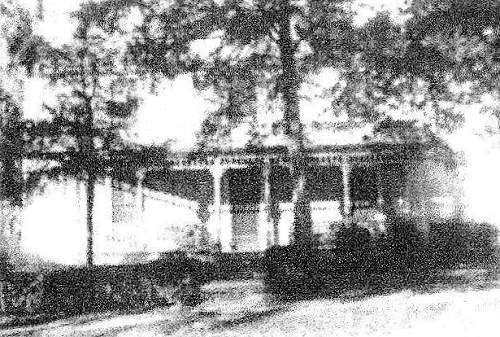
19 Schell Oligschlaeger Home Up until the depression years, the Schells were eminently successful in the mercantile business. They had all varieties of merchandise that a country store would have. They were big traders in wool, hides, and furs. Almost any commodity that came out of that territory was sold or traded. They particularly traded in railroad ties. I remember that they lost a raft of ties in a flood on the Osage River one time that nearly ruined them. They lost control of the raft in high water and it was destroyed.
Of course, they could not salvage the ties so they lost all that they had invested in the goods. I know it was quite a catastrophe for them.
When the depression came along, they were hurt very badly by extending bad credit to customers and Grandpa Schell’s brother Pete lost a lot of money in a music store in Jefferson City. The trading company was backing him and all they recovered from that was a player piano. They had it in the parlor for years. They had a lot of piano rolls that I remember as a kid. They lost their shirts in that venture.
Otto and Clarence Schell, my uncles, were both very personable people. Uncle Roe was more reticent. Otto Schell was quite a politician. He was the first Democrat ever elected to office in Miller County. Of course, it happened in the Democratic landslide of 1932. He was elected two more times after that and was the only Democrat in that county to hold office after the landslide. He was elected to be county treasurer and later as county assessor (photo 20).
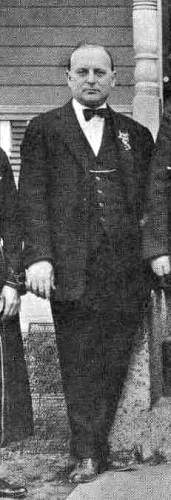
20 Otto Schell Note: you can read more about Bob’s very well known Uncle Otto Schell on our website written by historian Gerard Schultz.
Ilde Schell was part owner of the St. Elizabeth Milling Company and on the church board in town. He was also involved in the ownership of the canning factory that was on the Rehagan property. There was a big canning warehouse there that I remember playing near as a child. We used to go down there on Sunday afternoon and play around that building. There were old canning equipment and cooking vats in the building. They canned tomatoes there as a town manufacturing venture.
The Schell family was very affluent at one time as were the Oligschlaeger family. However, they came to very sad ends. Ilde, of course, was very familiar with everyone in town because of his postmaster position. Being a merchant he was also a very sociable man. He went to business school at Springfield Draughon. I am not aware of any university or college training that he might have had but he was a well educated and well read man for his era. I think he attended business school as a young man before he was married.
Not too long after he retired, he had a stroke and after that he could not control his emotions. He was in his late seventies then and I remember that he cried all the time. I can remember that we would drive over to visit him with Mom and he would be sitting on the front porch crying when we would drive up. It was around the time that Susie was born. Grandma Schell lived another 5 or 6 years after that.
Note: you can read more about the Schell family and their stores at this previous Progress Notes.
Here are some photographs taken from that website (photos 21 and 22):
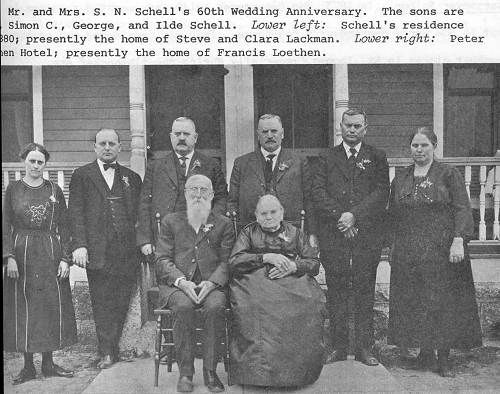
21 Schell Family
Click image for larger view
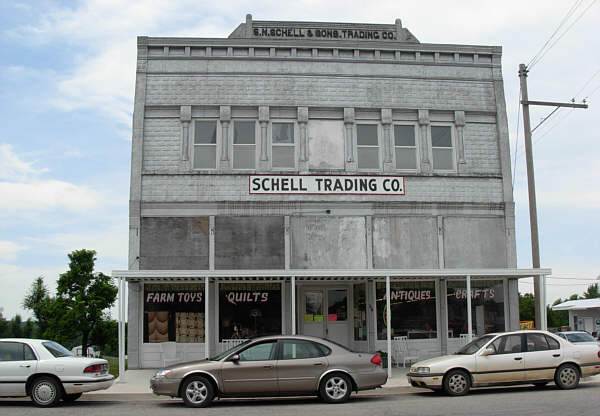
22 Schell Trading Company in St. Elizabeth Uncle Otto also went to business school and he helped in the store before he ran the restaurant. That place was a saloon before prohibition prohibited the sale of liquor. During prohibition, the place became a confectionery and restaurant. Otto did very well there when beer came back in and was sold at ten cents a bottle. I bought a lot of beer there when I was under age. Nobody really enforced the drinking age back then because it was not a problem. People weren’t drinking and driving or drinking to excess as much.
On Sunday morning in the early 1930’s people would come to town to go to mass and then they would go to the tavern for a schooner of beer. That would be the only beer that they would drink that week but they would have one after mass. I can just picture the old German steins as the men would stand there with them in their hands. Some of them had mustaches. A lot of old timers then were so German that they could barely speak English like Herman Libbert and dozens more.
Some of them also made home brew during this time. They were also cooking whiskey. There was a period of time when not a farm along the Big Tavern from St. Anthony to the mouth of the Osage River didn’t cook whiskey. Most of it was for personal use but a few of them sold to bootleggers during prohibition.
German was the predominant language spoken at St. Elizabeth in the first part of this century, but my folks never spoke German at home. They were insistent that we speak English in the home but we were one of the few families that did. Now I regret it. I wish I had been taught both languages, although I would probably have a German accent now if I had learned German first. Some of the people around St. Elizabeth still have German accents. That wouldn’t be so good either.
Grandma Oligschlaeger worked more as a field hand during her life than she did as a house keeper. I am not sure if it was from desire or necessity. Even after they moved off the farm, she would walk down to John Rhodes’ place and hoe corn all day long for him. She was just a little woman but she was quite a worker. I walked down there with her many times as a young boy.
She was pretty stooped over from osteoporosis. She was a school teacher in her early years. That is how she acquired the money to buy her 40 acres. She probably only paid a dollar an acre for it which was probably her year’s salary for teaching school. That was before she was married.
She was not a good cook but she did make good graham bread that she taught my mom to make. Grandma Oligschlaeger ate a lot of barley soup. She made it from greens from her garden like kale, spinach, and mustard greens. That was pretty much the summer time staple of her diet. She was not good at baking other kinds of breads like white bread. She never came up to our house to eat…never. She was sort of reclusive but in those days it was customary for women not to go out socializing too much. They were to be useful and not to be seen or heard.
Mom did not learn to cook from either her mother or her mother in law. However, in spite of her lack of role models, she became a good cook. Aunt Tillie and Mrs. Swelterman were also good cooks. Maybe that came from the Schell side of the family.
Note: Here is a photo of Robert and his siblings in front of their family home (photo 23):
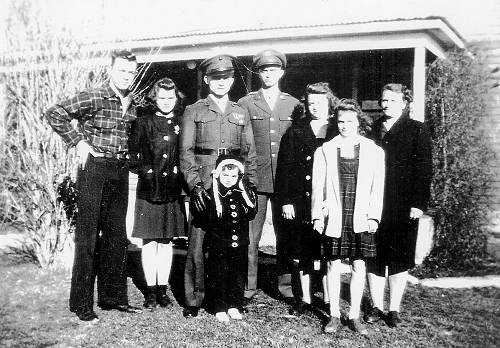
23 Oligschlaeger Family - Jadie, Delores, Urban, Leroy, Blanche, Jeannete, Alma and Helen
Click image for larger viewGrandpa Oligschlaeger’s Halloween Prank
This happened before my memory of it and I was told about it in later years. It occurred possibly in the mid 1920’s. As a Halloween prank my father, Ben and some of his friends decided to play a trick on Mrs. Frank Otto. She was in the habit of milking her cow early in the morning while it was still dark. They had a barn or really a cow shed on the property where John Kirkweg used to live and that was where they kept their cow overnight. It was totally dark in there early before the sun came up so my father found a gentle mule from somewhere, maybe it was one of ours…Jack or Jenny. Anyway, they removed the cow and slipped the mule in its place during the night so that when she went to milk in the early morning she was much surprised. Nothing of any harm really happened but of course she was upset when she realized that she had been trying to milk a mule. That upset her to no end. There was quite a ruckus over it. No damage was done except I guess it frightened poor Mrs. Frank Otto out of her wits.
In my youth, Halloween was quite a thing around town in that a lot of machinery was brought into town from the farms and placed in the middle of the streets to block traffic as a prank. Also, Schell Store had an overhanging roof that extended out over the sidewalk which prompted young men to put items on top of it. They also turned over out house s and just other pranks. Of course, turning over the out house was quite an inconvenience since no one had indoor plumbing or running water in St. Elizabeth back then. Of course, the young men got a bang out of that. I was never involved in anything that dramatic or serious. I did participate in switching some things around but never anything like a mule for a cow nor did I ever turn over any out houses. But we did have a good time. We mostly played tricks on the people that we didn’t care for…like Ben and Tony Evers. They lived where Grandma Massman used to live in the Engenschwaller home. It was quite a large part of our fun until we started into high school and then we pretty much stopped doing that.
Chapter 2
My Earliest Years
The earliest memories I have of myself that I can definitely recall lots of details were of my first day of school in the first grade. I was six years old then but I have no earlier memories. The school was on the church property between the present church and Schell’s Store. It was right up next to the street on the corner. The pump that is still standing was at one corner of the school house and it served the school with water. The school was divided into two rooms. The lower grades were in one room closest to the bank and the upper grades were in the other room closest to the rectory. It was a public school but it was operated as a Catholic school. We had a parochial school education in a public building. Nobody complained because there was only one non Catholic family in the community at the time…John Rhodes’ family. They always came to school at 9 o’clock because we had mass at 9 o’clock and religious instruction from 8:30 to 9 o’clock in the church.
The only instructor that I had for religious teachings was Father Herman J. Mayer. I had a very close relationship with him. He asked a number of times especially for me to serve mass for him. He was quite a disciplinarian but I never had any trouble with him. He was the bridge between the totalitarianism of Father Bruch and the more liberal priests of later years. Father Mayer was at St. Lawrence Catholic Church from 1929 to the late 1950’s.
The school day started at 9 o’clock; the teacher taught so many minutes to each grade level in one subject. I remember my first grade teacher was Ella Berkel and she taught grades 1-4 in the same room. People always ask me how I learned to spell the last name “Oligschlaeger” but I honestly was not ever conscious of having to learn to spell it. My brother Leroy was also in that class. He was two years older than I was but only one grade ahead of me in school because he did not start school until he was seven. Later Leroy skipped a grade and was then two years ahead of me until I also skipped the sixth grade. Once again we were only a year apart and it remained that way all through high school.
We only had eight months of school and never took off for snow even though some kids walked 3 and half miles to school through the snow in blizzard conditions. Classes were from 9 to 12 in the lower grades with a 15 minute recess in the morning around 10:15. We had an hour off for lunch but I never ate lunch at school. We walked home for lunch daily in grade school. Most of the time we ran home in three minutes and took 5 or 10 minutes to eat. Then we ran back because we wanted to have our play time. It was exactly one quarter mile.
Even in the “little room” we would play baseball with a rubber ball and stick bats. We played “prisoner’s base” and “dare base.” The boys played on one side of the church and the girls played on the other. There were no coed games that I recall. We did a lot of sledding and skating in the winter time and we formed our own skating rink. We went round and round the school in the snow with the sleds. The big boys always pulled us and years later I returned the favor and pulled the little ones. We had a big sled from home and I really enjoyed that. We had to furnish all of our own equipment because the school had nothing for us to use for play.
There were approximately 60 students in the whole school and roughly half of them were in my classroom. There were actually eight students in my class. They included Nettie Kemna, Rose Stuckenschneider, Ben Wankum, Roman Sabalke, Jake Leuckenouff, and Roman Verhoff. There were others who came and went. For instance during one year when they built the highway to Tuscumbia, some of the construction workers’ children also attended school with us. We called them “foreigners” because they were from out of state.
Some of the construction work on the road to Tuscumbia was done by small bulldozers, some by hand labor and some by teams of horses and mules. This, of course, was of great interest to the children of the school.
Ella Berkel was a good first grade teacher. She along with all of my other teachers except for one was quite a disciplinarian. In the second grade, I had Margarite Delaloy who later married Louis Kemna. She was from over around Vienna so, of course, we considered her a foreigner. We learned a lot. In the third and fourth grades, I had Theresa Groener. She lived on a farm where Clarence Bax later lived and traveled to school. I think her father brought them everyday. Her brothers, Paul and Hubert, also attended school with us. She was an excellent teacher and I learned a lot from her.
For the entire three years that I was in the “big kids room,” I had Ella Berkel again. I think I also had Jennie Bax for a while as a teacher.
The lessons were about reading, writing, arithmetic, spelling, and penmanship. Penmanship was my worst subject. I have never had a good handwriting which is why I print everything now. The method that we used for penmanship was not just the use of the fingers, but was a method that used the whole lower arm in movement. We did exercises making straight lines, slanted lines, and loops and circles. We repeated those over and over again.
I think that was really the extent of our early years. I can remember the cards that were put up above the blackboard which was all the way across the front of school about 30 feet long. The cards had words on them that helped us learn to read by sight. We repeated the sight words and how to pronounce those simple words which helped us learn to pronounce longer more difficult words. There was really no syllabification study or phonics. I never learned the ABC’s until I went to high school. I had to learn it then because I took typing, but we were not taught the ABC’s to learn to read.
The books we used for reading were called “primmers.” They were small books but pretty advanced compared to the children’s books of today. There was a primmer for first grade called The McGuffey Readers. Each grade had its own primmer from McGuffey that got harder and harder (photo 24).
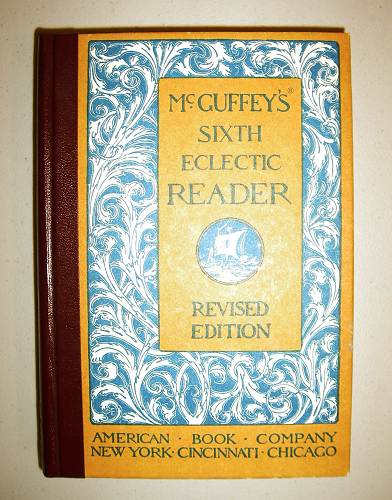
24 McGuffey's Reader We had some spelling matches from first grade through eighth. We chose sides and had teams that tried to beat the other team. We had all four grades participating in the same match. Sometimes we had spelling bees where we eliminated everyone down to the last one standing.
We also had ciphering matches in arithmetic. They were quite interesting. We did them at the blackboard with one student competing against another. We were given difficult problems in multiplication or long division. I was best at multiplication. We also had teams for this. I was often chosen for teams in those matches. I didn’t always win those events but I always competed well. Leroy was an exceptionally able student. Academically, he was my superior but in sports I was the better one. He was not really interested in sports until later years when he envied the fact that though I was the younger of the two, in high school I was on the first team and he was on the second. He was much taller than I was but I was the better athlete.
As we advanced in our lessons and grade, we moved across the room to the next level of learning and another grade level. The first grade was nearest the stove. Boys and girls were not segregated but the students were arranged according to size. The smallest desks were in the front with larger ones in the back. I generally sat fairly close to the front.
Each of the other three classes spent time preparing lessons, studying and reading or they listened while the first class was receiving its lessons from the teacher. I listened to the upper grade lessons all the time. I also did homework and studied at night so that is why I was able to skip a grade. I guess I could have skipped all four grades at once since I listened to them all everyday.
I was a good student. I always made the highest grades in my class all through grade school. That did not carry through to high school. Though I was also a good student in high school, I was not either valedictorian or salutatorian because I was very involved in sports. I was a sports hero of sorts and studying or taking a book home was I thought beneath me.
Grandma was so proud when I skipped 5th grade. She said, “Skip a grade. Oh, you are so smart.” But it was the one of the worst things that could have happened to me in school. I got out of high school too soon. I was too young. I wasn’t ready to go out in the world. I also lost a growth year for an athletic career. I was good for my age but I was always undersized compared to the boys in my class. Just think what I would have been like if I had had another year of growth. I was only 5 foot 5 inches tall when I graduated from high school and only weighed about 135 pounds. I put on an additional four inches of growth after high school.
We memorized math facts and I learned the multiplication tables from 2 to 12 when I was in the third grade. Then we learned how to divide. Memorization came very easily for me. We started with simple blackboard work. The teacher would put up a problem like 2 plus 2 and we had to memorize the answer.
Sometime while I was still in the little kids’ room, I think it was in fourth grade, I memorized the poem “Twas the Night Before Christmas” for a Christmas pageant. I stood up on a stage in the school that had wire strung across it with feed sack curtains and gave an individual recitation of that poem. I was not a good actor but I knew my lines. I did play some acting parts in the older kids’ room. We also studied geography and history in the little room. We had a fifteen minute recess in both the morning and afternoon.
In the big room, we studied a course in agriculture. I remember learning about various breeds of hogs and cattle. We learned the names of different varieties of corn. It was rather elementary agriculture. I particularly remember that the most common corn raised in those days was Reeds Yellow Vent. It was the corn raised in Iowa that gave Iowa the nickname “The Tall Corn State” because that variety would to grow to be 9 or 10 feet tall. My gosh, we raised that corn in the bottom land and I wasn’t tall enough to reach the ears. It was that tall. We raised Poland China Hogs and you don’t see that breed anymore. Many of the animals that were raised when I was a child are no longer in existence. They have been replaced by better breeds.
We also learned very elementary Algebra in the 8th grade and we had geography matches in the upper grades. After the students were divided into teams, we used a map of Missouri, the US, Europe or another continent while the teacher sat in the front of the room and picked out the name of a town on the map. The team that found the location first would holler out “got it” or something indicating that they had located the town and they would be awarded a point. Whichever team accumulated the most points in the allotted time would win the match. Though we had no prizes for winning, we were happy with just the honor of winning.
One time though when I was in the fourth grade with Theresa Groener as the teacher, we had some sort of a contest that ran over a period of time. We were competing for a prize. It was a set of 50 cards that had bird pictures on them. They were the size of a calling card. There were some birds that were common around home and some birds that I had never seen before or since. I do remember that one of the cards was the California Woodpecker (photo 25) and one of them was a Scissor Tailed Flycatcher (photos 26).

25 California Woodpecker

26 Scissor Tailed Flycatcher I have actually seen a Flycatcher twice in my life. Once when I was visiting Fred and Helen and once when I was visiting Rex Wyrick. I recognized that bird from those cards from fourth grade because I won that contest and really studied those cards. I really valued that prize though it probably didn’t cost over a nickel or a dime for the teacher. Actually, the cards were a part of the Arm and Hammer Soda promotion obtained by saving a box top along with a small amount of money. Those cards have been long gone, but I learned a lot from them and recognize birds today from studying them. They were a real treasure to me.
Classes were over by four o’clock and then we had to do chores at home. I started doing chores at a very early age because I was strong for my age. I had to feed chickens, gather eggs, slop hogs, and carry in wood. Later, as I was older, I hand milked cows all through high school. We sold and delivered milk for a nickel a quart. It was a good source of income. It kept us going and we also sold chicken eggs.
We had 5 or 6 cows that we were milking. I milked two and Mom milked the other 3 or 4. That was pretty rough on cold winter mornings even though we milked inside the stable. The cows didn’t like that. They would kick the **** out of you. I never used a stool to milk. Mom used a stool in later years but mostly I remember we just squatted and milked. I knelt a few times to milk when the environment allowed it. We milked out in the open in the summer time.
When I was big enough, I was taught to turn the cream separator. We used to sell a lot of cream along with our milk sales. At one time we were probably selling to 7 or 8 customers. Henry Schulte was our original customer. He drank a lot of milk because he had ulcers. Now we know that’s probably the worst thing to do for ulcers, but then we didn’t know better. He thought it eased his ulcers.
We cultivated and farmed the ridge behind the barn and behind Grandma Oligschlaeger’s house. We planted about three or four acres in hay or corn that we used for fodder because it was not a good stand. We never did get any grain off of it. We just used it for the cattle. We used mule drawn equipment. I started with a team of small mules when I was 12 or 13 years old. I learned to harness them and then plow corn with them. I also used a hay rake and mower to gather hay. We collected loose hay and never baled hay on the farm. Baled hay didn’t come until later when we brought in hay from Nebraska and the Dakotas during the drought. It was prairie hay that had very little feed value but it kept our animals alive during the two drought years when we could raise no food for them. That was 1934-36. Those were terrible years. Later, after Dad was killed, we used the land for pasture and no longer farmed it.
My father had on a number of occasions asked the question, “I wonder how much that barn loft will actually hold?” We had never had the loft full of hay until one year. We cut hay from the Oligschlaeger farm down below the ridge. The wagons were so heavy that we could barely pull them up the ridge. It took 40 oversized loads to fill the barn.
I always figured that there must have been at least 3 tons of hay on each load because hay is very heavy. So that would have been 120 tons of hay in the loft. I wasn’t old enough to have hauled the hay but I remember riding along on top of the wagon to town. We would have to switch teams along the way because of the heavy burden of the hay load. We would stop, unhitch a team, and hitch up another team to finish the pull up the hills. We would then bring both teams down to the bottom of the hill to bring the next load up. Those horses were so strained from the load that sometimes they went down on their knees in the road bed. It is only a quarter of a mile distance but there was a really steep hill to climb that had a curve at both the top and the bottom of the steep grade. It was very difficult to pull. I have seen Model T’s back up that hill if they didn’t have enough gas in their tanks to make it up frontwards. They would run better in reverse than they would forward anyway.
We had a Model T Ford, a 1926 model. We bought the car new at a little over $500. I don’t remember when they bought it because I was only two years old but I do remember riding in it. Then the Depression came along and we couldn’t buy gasoline for it. We also couldn’t afford to license it so it sat in the corn crib next to the barn. Finally, we sold it for $10 to Irvin Curry. He fixed it up and it ran for a long time. He was the manager of the Exchange there in town. He drove it between work and Capps for a number of years. I wish I had it now. I remember riding in it. It was a touring car with curtains in it. I remember going to Meta in the car. We went every fall to buy apples at the Exchange in Meta. They didn’t come in baskets or we couldn’t take the baskets with us so we poured them into the back seat of the car and filled it up till it was full. Then we brought them home like that. I remember seeing the back full of apples several years.
Note: Irvin Curry was married to Barcie Abbett who was a sister to my grandmother, Sadie Abbett Bear. I remember visiting their farm on Humphrey’s Creek several times as a young boy (photos 27 and 28).
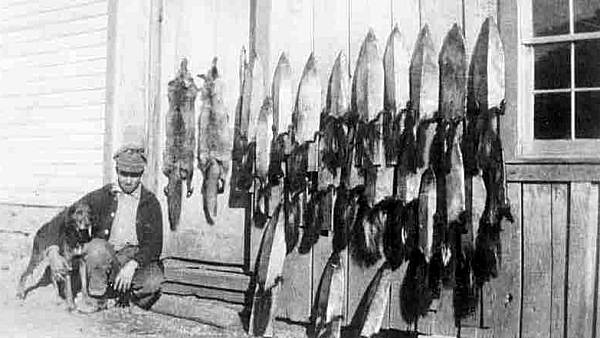
27 Irvin Curry - Husband of Barcy (Abbett) Curry
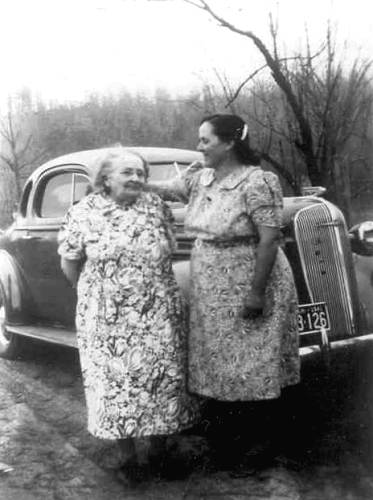
28 Susie Abbett and Barcy (Abbett) Curry - Her Daughter Before the MFA was built in St. Elizabeth, we did a lot of trading in Meta at the MFA. The prices were better because Shell’s store was very expensive. They were buying railroad ties and were at one time the biggest tie dealers in the area. The store bought ties locally, hauled them to Meta to the railroad yard. They also floated ties down the Osage River. They were really green wood and very heavy. I remember many a tie load going by the house when I was a young boy. I think 10 or 12 would be a load that was heavy enough for a team to pull over the steep hills to Meta.
Electricity, Telephone, and Water from the Early Days of My Childhood
Electricity
Leroy was not as able bodied as I was, so he read a lot. We studied by kerosene lamp although I remember when we got electricity which was not long after I started to school.
Grandma got electricity in her house in 1929. It was wired with old knob and peg wires that are probably still in there to this day. A fellow by the name of Albert Groener from Meta wired it. We were served by the Western Light and Telephone Company at first. The electricity was supplied by a generator that was oil driven. It was located at Meta and that generator serviced the Meta area, the St. Elizabeth area and I think several other areas.
Shortly after Bagnell Dam was built, then we were serviced by Union Electric from the dam. They bought out Western Light and Power and serviced the surrounding communities. Their only source of power was the generators powered by the water from the Osage River. They later built some oil or coal generators but not in the beginning. Now it is only used as an auxiliary power source during high energy times or when they need to sell it to other companies. The dam is now owned by Ameren UE.
First we had electric lights and then we bought a Montgomery Ward wringer washing machine. It lasted a long, long time. It was quite a nice machine because we had a little money in those days. Then we got an electric iron to replace the sad irons that had to be heated over the wood stove for ironing clothing.
Before the washing machine was bought, Grandma Oligschlaeger and Mom washed every Monday on a wash board…rain or shine. That didn’t make any difference… Monday was wash day. They did it all by hand.
Power was cheap in those days. There was a minimum charge of three dollars a month and we sometimes didn’t pay anymore than that. It was only a cent or two a kilowatt.
They heated the water for washing by hauling it and heating it on the old cook stove that sat in the kitchen where the bathroom was later built. There was another window in the kitchen then that used to open onto the porch where the hot water heater is now.
Water
Plumbing was put in the house in the late 40’s or early 50’s using cistern water as the source. There was running water in the kitchen and bathroom. That was quite an improvement.
The cistern was not a reliable source especially in dry summers as it would run dry. Then we had to haul water from Capps Springs to restore water to the cistern. I can remember years prior to that when we hauled water up from the well down in the holler to water the chickens and for use in the house. That was in the drought years of the 1930’s. We carried water in buckets by hand. That was a lot of hauling for Leroy and me but it didn’t seem too big a job at the time. Dad helped also.
The cistern was Grandma’s source for water until the wells were dug for the turkey house that was built in 1963-64. We drilled a well behind the smokehouse. It is still there but I don’t know if it is still in use. Anyway, I had that water pumped into the house for home use as well as for the turkey house. The cistern was no longer used after that. The pump is still on the property as far as I know.
We never had a problem with water contamination from the cistern or from filling it with the spring water, but we did have a problem sometimes with food contamination before we had refrigeration.
Later the St. Elizabeth Water Company was started and we used that for our water at the home place. That was good water.
Telephone
We had a telephone for many years even when I was a small child, but there was a point at which the dues for phone use were $4.00 a year and we could not afford to pay them so we had to discontinue our phone service. We had a wall type phone with a hand crank but it was there for many years out of service. Grandma did not get a table model until Triangle Telephone offered service to Iberia, St. Elizabeth, Crocker, and Dixon. They put in a dial service and she got a dial phone. Eventually the company became known as GTE or General Telephone Equipment.
At mom’s and at our home, we had a private line. It cost more money. Originally we had to ring a local operator and she would manually connect us with whatever number we were calling. Everyone was responsible for servicing their own line in the system. People on a party line shared those responsibilities by coming together to cut brush or check for repair needs. On a private line we had that responsibility ourselves.
I was instrumental in later years after we moved to St. Elizabeth for getting the dial system to the St. Elizabeth area because I was Secretary\Treasurer of the community telephone board. I wanted Southwestern Bell as our provider but they were not interested in servicing our area so they referred me to Triangle which became our service provider. Along with me serving on the board was Herman Huhman, Martin Evers, Ledwina Bode (the local phone operator), Herb Nilges, and one other. There were five of us. We had a mass meeting and presented our proposal to the community and it was adopted.
Refrigeration and Butchering
Things were pretty primitive in those days as compared to what we have now. We did not have a refrigerator until after WWII. We used the cellar to store things that required cold storage.
There was certainly no meat market in town so every one in town and in the outlying areas butchered their own meat. Mostly that was done just like the threshing and major harvesting. It was a neighborhood effort with families helping neighbors. They butchered at one farm for a couple of days and then moved on to the next. It had to be done in cold weather to prevent meat spoilage. At our home, we butchered about 8 hogs a year for our family when it was at its maximum size. We would butcher 4 before Christmas so we would have Christmas morning sausage and then we would butcher another 4 after Christmas.
The process included killing and scalding right there on the home place. We would build a big fire to heat the huge kettles to scald the hair off the hides of the hogs. That in itself was a huge job. I remember my grandmother Oligschlaeger helping with all of that. Even though she was a little woman, she was quite accomplished and skilled working with the butchering. She was used to it. Though it was hard, hard work she like to participate. Of course, that is how she got her own meat supply too.
Seldom did we butcher cattle. We butchered far more sheep than cattle because that is just the type of herds we maintained. Cattle were also too valuable to eat. We used them mainly for milk, butter, and cottage cheese; but hogs were only 8-10 cents a pound and produced nothing but meat for us. In the early years of the depression and the drought year of the 30’s, we couldn’t give them away. There were just too many of them and the price was so low. We used them for our main meat source.
Butchering was always a two day affair at each farm. The killing, scalding and hanging meat to cool down occurred in the early morning of the first day. It could not be freezing temperature but the weather had to be pretty cold to cool down the meat without fear of contamination. Meat was hung on scaffolding that was erected outside. Ours stood out from the back porch (the porch was totally open then). I can still see that in my mind’s eye after all these years. The scaffold would hold 3 or 4 hogs at a time. One end of it was laid up on the sill of the porch and the other end was a triangle.
That is where the eviscerating and the cleaning of the hog also took place. Later in the day, the carcass was cut into halves and then into quarters to place in the smoke house for the cooling down period overnight. The meat was trimmed that evening to prepare for the next days activities. Hams and shoulders were shaped and trimmed and the trimmings were prepared for the sausage and lard.
Most of the first days work was done by the men, but I do remember my grandma Oligschlaeger being the exception. The women did not have much to do this first day and actually the men’s job that first day did not take a long period of time. It was hard work with lifting and scalding but not too much time consuming.
But on the second day, the women were very busy. Sausage had to be made. Lard had to be rendered.
We made three kinds of sausage. There was what we called “met wurst” or meat sausage, “blood wurst” or blood sausage, and “liver wurst” or liver sausage. They are just exactly what the names imply for ingredients. They were all head and scrap meat from the trimmings mixed with blood, liver, or other scraps. The blood sausage had a rather pungent taste that I liked. I had no qualms about eating it then and would not today though a lot of people did not like it. The liver wurst was a whole lot like braunswager is today, only I think it tasted better (photo 28a).
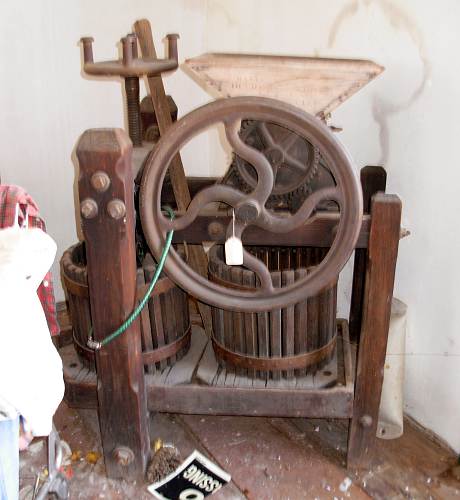
28a Sausage Grinder The “met wurst” is what most of you kids remember having on Christmas morning at Grandma’s so you should all remember what it tasted like. The recipe for that was a tub of ground pork meat, a handful of pepper, and a pound of salt. Other than that there was no seasoning like sage. Other people did that but my family and I particularly did not like sage in sausage. I have eaten a lot of different homemade sausages in the community and others over the years and I can honestly say that I liked Mom’s the best.
My grandma Oligschlaeger always missed the sausage and I would help her stuff it as did the other kids as they became old enough. It was sausage like you can not get in the stores now. It was special.
She also helped Mom to render the lard. That required a lot of heat to render lard out of the fat trimmings. There was only fat, no lean in the kettle. We primarily had two grades of fat. One was leaf lard. Hogs were bred to be fat in those days to provide an abundance of lard for preserving the meat and to use as shortening for frying and all cooking and baking. There was no such thing as vegetable shortening in those days even in the cities. The “leaf lard” was the fine grade and it came from the side of the hog inside the body cavity not on the outside. On a large hog that fat was a couple of feet long and a couple of inches thick and as wide as both my hands It was a big hunk of fat that extended on each side of the hog just like an organ of its own especially used for rendering. It was ripped out and that made the finest lard but it did not make enough. Most of the lard came from the bacon sides of the hog that were 2 or 3 inches thick. If a grocer sold something like that now, he would be shot because it was so thick with fat. Hog breeding now has almost eliminated all the lard.
Early in the morning of that second day the lard was cut into small chunks that were constantly stirred until the fat was squeezed out of the chunks leaving something called “cracklings” behind. They were tan crispy pieces of fried down lard. This required a hot fire and constant, I mean constant, stirring process so that the lard did not burn. That is what my grandmother Oligschaeger always did and she was good at it. I can still see her out there by the hour just stirring and stirring slowly to keep it from burning in a fifty gallon iron pot. She used a large wooden paddle to stir. She would then stop for a few minutes to throw a couple pieces of cook stove wood under the iron pot to keep that fire hot. She would then resume her stirring for hours. She did that out in our back yard and it took most of that second day.
After the lard had cooled down late in the day, then it had to go through the squeezing process. After the sausage had been finished, the sausage press had a special attachment that was used for the lard/crackling squeezing process. We put this stuff under pressure just lie a cider press. The lard flowed from the press in a stream about as big as a cigar from the end of the nozzle on the press. It cooled, hardened and needed to be as white as possible. If we ended up with gray lard, we had not done the job right. But, of course, we did not know the outcome of the color until the final step when the lard hardened and set up its color. It was then stored in the large stone jars for preserving other meat and cooking, baking or frying. We thrived on it, but now it is not used. Some things surely taste much better with that lard than with a vegetable cooking oil and the Mexican population still used it a lot.
Nothing on the hog was ever wasted. The ears and feet were used to make head cheese along with portions of the head meat. The jowls were sliced just like bacon and fried. A lot of that meat was fried down and placed in large stone jars or crocks and then lard was poured over them to preserve them from the air. They were stored in the cellar and that kept well up into the summer months…just a few months shy of the next butchering time.
The hams, bacon, and shoulders, were trimmed to their final size in the sausage making process and they were then hung in the smoke house. In the early days they were hickory smoked after they had hung and dried for a while. Then they were packed in salt for further preservation. We had a big wooden chest in the smoke house that was used for that purpose. The whole chest was packed in salt so they were well preserved with the smoking and salt packing. Later on we used a sugar curing process in that they were packed in a mixture of salt, sugar, and pepper, but not put away in a chest. These were wrapped and hung in the cellar. That was really delicious meat. I have not had anything like that since.
The sausage was mostly eaten for Christmas, but everything else kept in the cellar through the winter, spring, and up into the summer just by that smoking, salt or sugar cuing , or lard packing process. Things never froze in the cellar but it was plenty cool down there to keep the meats and vegetables.
Occasionally we butchered sheep when I was young because we almost always had a flock of them. We kept them up until my later years in high school. At that time our herd contracted a disease that killed about half of them and so we sold the rest to prevent that from happening again. We did not know what the problem was but we called it “pregnancy disease” because they were all heavy with lambs at the time so it was quite a loss to us…the sheep and the spring lambs.
The lamb was not cured in the same manner because we ate it fresh. Extra meat was given to neighbors and family so that it would not spoil.
Beef sometimes was preserved by a drying process but I can honestly only remember butchering one or two beeves in my lifetime. Of course, we had very few beef cattle because most of our cattle were dairy cattle and we couldn’t afford to butcher them for meat.
My best memories of Grandma’s cooking brings a lot of good food to mind. I must admit that I did not properly appreciate them at the time, but would really appreciate them now. For instance, we never did have baker’s bread or what you call “store bought bred.” Instead, Mom always baked bread twice a week and probably made 6 or 8 loaves each time…big loaves. Some of the best in the world. Now I would love to have it all the time, but when I was a kid we thought that having “store bough bread” would be such a treat. Now, I appreciate the difference. The other stuff is hardly fit to eat in my opinion.
Mom made an excellent chili and Marj can make a chili that is quite like it…almost identical to Mom’s and it is very good. However, Marj, like Mom, only wants to make it in big batches so she doesn’t make it that often with just the two of us. Mom made it in huge batches when we were all at home and even in later years when we were all going to be there for some purpose. Mom always made it in a huge blue cooker pot.
Mom also made excellent sauerkraut. At least other people really thought it was excellent, but I was not much of a fan of any sauerkraut then or even today.
She was especially good at creaming peas and carrots. She cooked a lot of vegetables the “old fashioned” way which today is considered “over cooking.”
I really thought her stewed tomatoes using bread were really delicious. I really like them but some of the kids did not. She made great pickles and a lot of canned goods especially the many quarts of peaches that one year.
Mom was a particularly good cook in my opinion but it was not necessarily German style. It was more country cooking with traditions that she had learned from her family and community that I guess you could argue was certainly German in nature. It was also influenced by her American roots. For example, she did not make anything like sauerbraten or hossenphefer or schnitzel. She did make “panouse” and head cheese when we butchered. I guess those were German.
Mom was really good at pies but not as good at cakes. Aunt Tillie was a whiz at cakes. Mom had a lot of cake failures for some reason. Of course, they were all made from scratch as that was before store bought mixes were available. We ate both the successful ones and the failures…it didn’t matter much to us as kids. They all tasted good even if they weren’t perfect.
She made a lot of cornbread but seldom made biscuits whereas the “Americaners” as we called them who lived in the rest of the county nearly lived on biscuits. They all brought biscuit sandwiches with cold meats for lunches at school even when I was in high school.
We took our lunches to high school, too. It is a surprise to me that we did not have more occasions of serious illness as the result of not having refrigeration to keep those foods from spoiling. We did have touches of mild food poisoning from time to time like everyone else in those days. It usually passed in a day or two.
Ham was our primary food for holidays like Thanksgiving or Easter. I don’t ever remember having turkey for any occasion until I got into that business in my adult years. We always had more pork than anything else with some lamb.
We did have a goose for Christmas every year. Mom would pick the feathers a couple of times every summer to use for new pillows and feather beds and then later in the year she would butcher the goose and we would have the goose for Christmas dinner. Those feather beds really kept us warm in the winter time. She would only pick the finest feathers and the goose down for her pillows. Those geese would sometimes bite her. That was quite a chore. She had to hold the head tight against one arm with the goose upside down while she picked the breast feathers and it would bite her. She would get all black and blue from the bites.
Thanks Bob for that very interesting narration of your memories of the St. Elizabeth community when you were a boy growing up there.
The book about St. Elizabeth to which I referred earlier written by Dale Doerhoff, A Trip To Charleytown, has an interesting story about the Ben Oligschlaeger farm in which he refers to this photograph (photo 29):
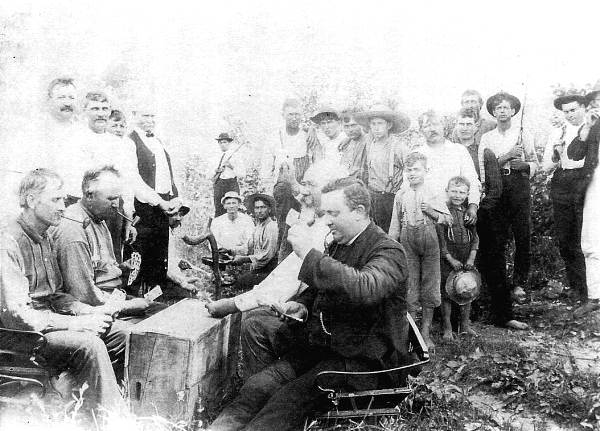
29 Chris Stuckenschneider, Ben Oligschlaeger, Joe Wilde and Fr. Bruch Although Beten und Arbeit (prayer and work) may have topped their list of priorities, Spass (fun) was important, too. All it took was a reason to come together. The occasion for the event pictured above was Independence Day, 1907. Men and boys gathered under a burr oak on the banks of the Big Tavern Creek on the Ben Oligschlaeger farm. They drank beer and played cards, using an upturned beer case for a table and buggy seats for chairs. They appear to be playing a game they called “Fossfangen” (Plattdeutsch for “catch the fox”). One of the objects of the game was to catch the “fox,” i.e., the ace of diamonds. In the photo, Joe Wilde is showing he has the “fox,” while the other three players act as if they are unaware. Fr. Bruch was in the thick of things, smoking his long stemmed, ceramic pipe from Westphalia. Not one to let familiarity diminish respect, the good pastor remained in uniform, wearing his Roman collar, vest and jacket, in spite of the July heat. Two years later the church choir enjoyed a similar event at the Oligschlaeger farm, and this was duly mentioned in the news:
“Our esteemed spiritual leader Reverend Bruch, Reverend Strassburger, and the church choir, made a trip to Ben Oligschlaeger’s place on the Tavern on the 5th of July in order to celebrate the 4th. They celebrated with good conversation, catching fish, and excellent food and drink. (VF, 8 July 1909)”
In the photograph, the card players are Christ Stuckenschneider, Ben Oligschlaeger, Joe Wilde (displaying the ace of diamonds…the “fox”) and Fr. Frederick Bruch.
Standing: Ben Wilbers, Frank Otto, Frank Keller, “Old Man” Riley, an unnamed bricklayer with rifle, George Ahart, August Dickneite, William Oligschlaeger, Clyde Davidson (large hat), Charlie Newbower, Mike Michael, John Wilde (partially hidden), Conrad Stuckenschneider (with rifle), Ilde Schell (with rifle) and Gus Rusmanusky.
The two boys; Ben, Jr. and Frank Oligschlaeger. The three men frying fish in the background: Anton Keller, Albert Klick and Pete Bax. Details of the day were provided by Frank Oligschlaeger in an interview with the author in 1980.
Frank was a brother to Ben and uncle to Bob Oligschlaeger.
St. Elizabeth, or Charleytown as it was called during the time about which most of this narrative has been written, also had a couple of bands which included some of the Oligschlaegers. The first was the Charleytown Brass Band which was photographed here in 1905 (photo 29a) and the second was the Charleytown Cornet Band which was photographed in the next photo in 1913 (photo 29b):
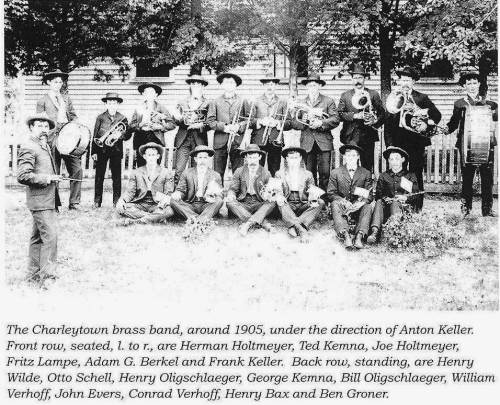
29a Charleytown Brass Band
Click image for larger view
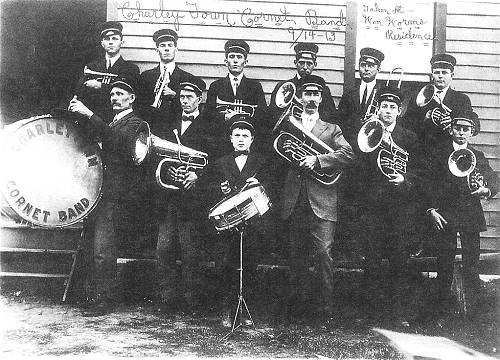
29b Charleytown Cornet Band - 1913
Click image for larger viewThe names for the Charleytown Cornet Band are as follows:
Front row, left to right: Frank Otto, George Kemna, Al Schell, John Schwietermann (director), Alphonse Bax and Clem Bax.
Back row: Henry Olischlaeger, John Worms, George Worms, Herman Luecke, Bill Oligschlaeger and Frank Lueckenhoff.
Former St. Elizabeth native Stan Huhman has been of great help to me putting together the story of Bob Oligschlaeger and his family.
Mary Oligschlaeger Wright has a shorter genealogical diagram pertaining only to her immediate family which she has put together for us (photo 29d):
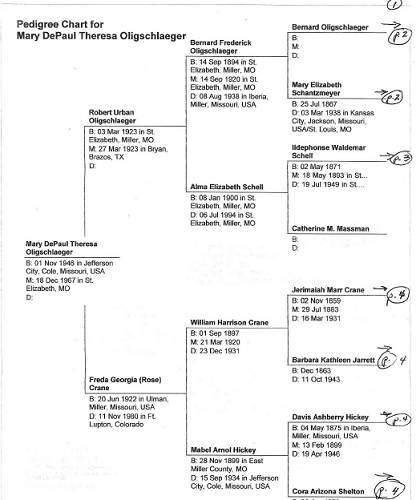
29d Mary Oligschlaeger Wright Genealogy
Click image to view complete PDF document
We have been working throughout the winter and this spring to improve and add to the exhibits in our museum. One area where period women’s clothing is displayed has been rearranged and enlarged (photo 30).
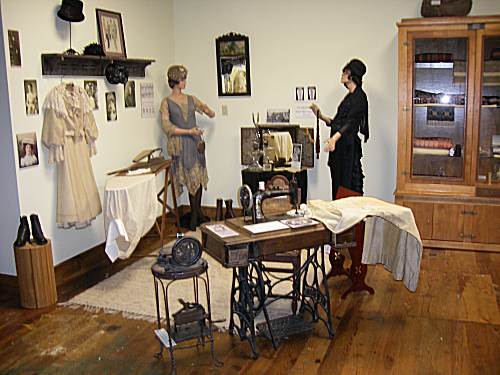
30 New Dresses for Models Our opening day for this year will be Saturday, May 15 when we will have an open house with refreshments and music by Joe Jeffries and his group. Come and see us and help us get the season started!
This coming Sunday, April 25, we will host a pot luck dinner beginning at 1:00 p.m. at the museum. All are invited. Entertainment will be provided by the Josh Wyrick trio made up of local residents Monty Lafoon on base, Josh on guitar and vocals, and Larry Wyrick on dobro. The trio recently performed at a fundraising event sponsored by the Tuscumbia High School Alumni Association (photo 30a).
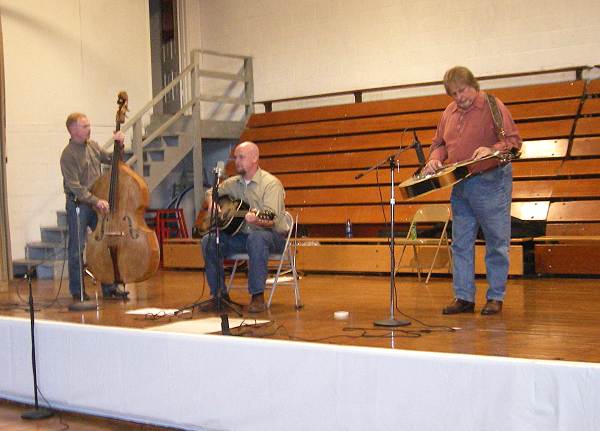
30a Josh Wyrick Trio We will have a members meeting to vote for the nominations for new members to the board.
Before ending this week’s Progress Notes here are some more Lake photos from Mike Wieneman (photos 31 - 36):
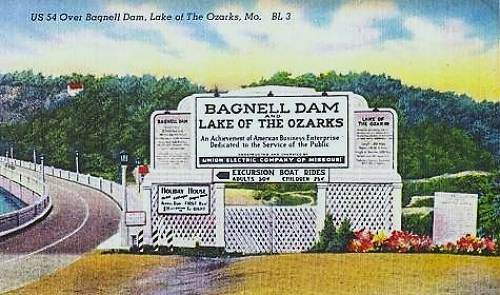
31 Bagnell Dam Sign
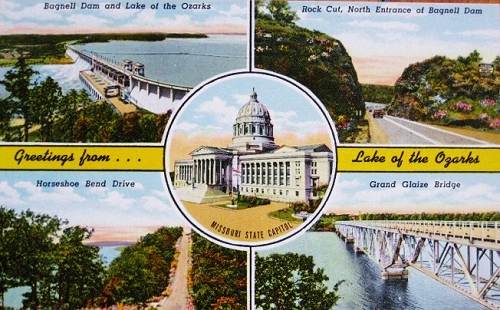
32 Greetings from Lake of the Ozarks
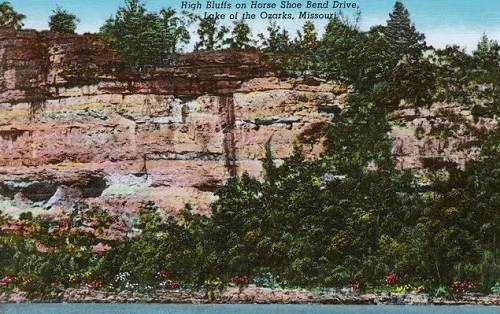
33 High Bluffs on Horse Shoe Bend Drive

34 Bagnell Dam
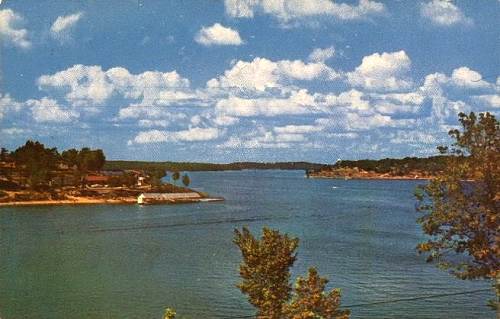
35 Lake of the Ozarks

36 Bagnell Dam Aerial View
That’s all for this week.
 Joe Pryor
Previous article links are in a dropdown menu at the top of all of the pages.
|

